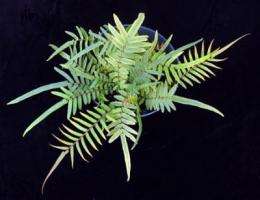Arsenic hyperaccumulating ferns: How do they survive?

Arsenic is toxic to most forms of life, and occurs naturally in soil and ground water in many regions of the world. Chronic exposure to arsenic has been linked to lung, bladder and kidney cancer, and thus there are strict limits on allowable levels or arsenic in drinking water. Chemically similar to phosphorus, arsenic forms arsenate (AsO43-), which closely resembles phosphate (PO43-). Arsenate interferes with many phosphate-requiring metabolic reactions, including synthesis of adenosine triphosphate (ATP), a ubiquitous and essential source of cellular energy. Thus, exposure to even low levels of arsenic can be extremely toxic.
In well-aerated soils, arsenic exists mainly as arsenate, which is taken up by plant roots using a phosphate transporter protein. Plant tissues rapidly reduce arsenate to arsenite (AsO33-), which is transported to the aerial portions of the plant. In aquatic environments or water-logged soils, arsenic exists primarily as arsenite. Whereas rice grains can accumulate up to 60 μg/g arsenic, the fern Pteris vittata (see figure) can hyperaccumulate arsenic to levels 1000-fold greater than this. A team of researchers led by David Salt and Jo Ann Banks of Purdue University have recently isolated a gene encoding an arsenite transporter protein. This transporter allows these ferns to sequester arsenic in the vacuole, a cellular storage compartment isolated from the cytoplasm by the vacuolar membrane.
In research published this week in The Plant Cell and performed primarily by graduate student Emily Indriolo (now a researcher at the University of Toronto), these scientists describe how they used an arsenic-sensitive strain of yeast to isolate and characterize a gene encoding the P. vittata arsenite transporter. Yeast cells are arsenic-resistant because their plasma membrane contains an arsenite effluxer protein that is encoded by the Arsenical Compound Resistance 3 (ACR3) gene. The researchers introduced a library of P. vittata genes into an arsenic-sensitive acr3 mutant yeast strain and isolated a gene that restored arsenic resistance to this mutant. The protein encoded by this gene was then demonstrated to be very similar to the ACR3 protein of yeast in both structure and function.
Sequence analysis showed that this fern protein contains 10 putative transmembrane domains, suggesting a cellular membrane location. Using an antibody that specifically recognizes the ACR3 protein, they showed that ACR3 is found in the membranes of vacuoles, but not in the plasma membrane or in endoplasmic reticulum membranes. This suggests a mechanism for arsenic tolerance in P. vittata tissues: arsenite that enters the cell is transported by ACR3 into the vacuolar compartment, where it is spatially isolated from the cell cytoplasm, the site of many of the cell's arsenic-sensitive metabolic reactions.
Furthermore, the researchers showed that ACR3 gene expression in P. vittata is induced more than 30-fold in the presence of arsenite. To verify that ACR3 is required for arsenic tolerance, the ACR3 gene was silenced using an inhibitory mRNA. In these silenced plants, ACR3 expression was not induced by arsenite, and arsenic significantly reduced the growth rate of these ACR3-deficient plants relative to unsilenced plants.
Sequence analysis showed that, although this gene is found in a wide range of organisms including bacteria, fungi, mosses and gymnosperms, it is absent in angiosperms. By studying the occurrence and function of ACR3 in various plants, including hyperaccumulating and nonaccumulating ferns, the authors hope to provide additional insights into mechanisms of arsenic transport, tolerance, and accumulation. In addition to potential benefits for human health, this research will hopefully lead to strategies for phytoremediation of arsenic-contaminated soil and water.
More information: www.plantcell.org/cgi/content/ … act/tpc.109.069773v1
Provided by American Society of Plant Biologists
















